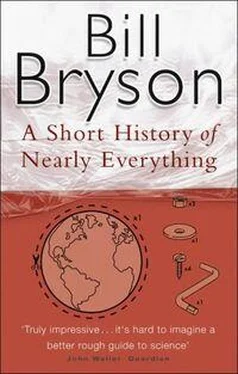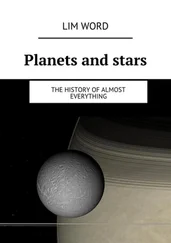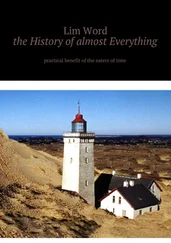Inspired by the controversy, in 1796 Cuvier wrote a landmark paper, Note on the Species of Living and Fossil Elephants , in which he put forward for the first time a formal theory of extinctions. His belief was that from time to time the Earth experienced global catastrophes in which groups of creatures were wiped out. For religious people, including Cuvier himself, the idea raised uncomfortable implications since it suggested an unaccountable casualness on the part of Providence. To what end would God create species only to wipe them out later? The notion was contrary to the belief in the Great Chain of Being, which held that the world was carefully ordered and that every living thing within it had a place and purpose, and always had and always would. Jefferson for one couldn’t abide the thought that whole species would ever be permitted to vanish (or, come to that, to evolve). So when it was put to him that there might be scientific and political value in sending a party to explore the interior of America beyond the Mississippi he leapt at the idea, hoping the intrepid adventurers would find herds of healthy mastodons and other outsized creatures grazing on the bounteous plains. Jefferson’s personal secretary and trusted friend Meriwether Lewis was chosen co-leader and chief naturalist for the expedition. The person selected to advise him on what to look out for with regard to animals living and deceased was none other than Caspar Wistar.
In the same year-in fact, the same month-that the aristocratic and celebrated Cuvier was propounding his extinction theories in Paris, on the other side of the English Channel a rather more obscure Englishman was having an insight into the value of fossils that would also have lasting ramifications. William Smith was a young supervisor of construction on the Somerset Coal Canal. On the evening of January 5, 1796, he was sitting in a coaching inn in Somerset when he jotted down the notion that would eventually make his reputation. To interpret rocks, there needs to be some means of correlation, a basis on which you can tell that those carboniferous rocks from Devon are younger than these Cambrian rocks from Wales. Smith’s insight was to realize that the answer lay with fossils. At every change in rock strata certain species of fossils disappeared while others carried on into subsequent levels. By noting which species appeared in which strata, you could work out the relative ages of rocks wherever they appeared. Drawing on his knowledge as a surveyor, Smith began at once to make a map of Britain’s rock strata, which would be published after many trials in 1815 and would become a cornerstone of modern geology. (The story is comprehensively covered in Simon Winchester’s popular book The Map That Changed the World .)
Unfortunately, having had his insight, Smith was curiously uninterested in understanding why rocks were laid down in the way they were. “I have left off puzzling about the origin of Strata and content myself with knowing that it is so,” he recorded. “The whys and wherefores cannot come within the Province of a Mineral Surveyor.”
Smith’s revelation regarding strata heightened the moral awkwardness concerning extinctions. To begin with, it confirmed that God had wiped out creatures not occasionally but repeatedly. This made Him seem not so much careless as peculiarly hostile. It also made it inconveniently necessary to explain how some species were wiped out while others continued unimpeded into succeeding eons. Clearly there was more to extinctions than could be accounted for by a single Noachian deluge, as the Biblical flood was known. Cuvier resolved the matter to his own satisfaction by suggesting that Genesis applied only to the most recent inundation. God, it appeared, hadn’t wished to distract or alarm Moses with news of earlier, irrelevant extinctions.
So by the early years of the nineteenth century, fossils had taken on a certain inescapable importance, which makes Wistar’s failure to see the significance of his dinosaur bone all the more unfortunate. Suddenly, in any case, bones were turning up all over. Several other opportunities arose for Americans to claim the discovery of dinosaurs but all were wasted. In 1806 the Lewis and Clark expedition passed through the Hell Creek formation in Montana, an area where fossil hunters would later literally trip over dinosaur bones, and even examined what was clearly a dinosaur bone embedded in rock, but failed to make anything of it. Other bones and fossilized footprints were found in the Connecticut River Valley of New England after a farm boy named Plinus Moody spied ancient tracks on a rock ledge at South Hadley, Massachusetts. Some of these at least survive-notably the bones of an Anchisaurus, which are in the collection of the Peabody Museum at Yale. Found in 1818, they were the first dinosaur bones to be examined and saved, but unfortunately weren’t recognized for what they were until 1855. In that same year, 1818, Caspar Wistar died, but he did gain a certain unexpected immortality when a botanist named Thomas Nuttall named a delightful climbing shrub after him. Some botanical purists still insist on spelling it wistaria .
By this time, however, paleontological momentum had moved to England. In 1812, at Lyme Regis on the Dorset coast, an extraordinary child named Mary Anning-aged eleven, twelve, or thirteen, depending on whose account you read-found a strange fossilized sea monster, seventeen feet long and now known as the ichthyosaurus, embedded in the steep and dangerous cliffs along the English Channel.
It was the start of a remarkable career. Anning would spend the next thirty-five years gathering fossils, which she sold to visitors. (She is commonly held to be the source for the famous tongue twister “She sells seashells on the seashore.”) She would also find the first plesiosaurus, another marine monster, and one of the first and best pterodactyls. Though none of these was technically a dinosaur, that wasn’t terribly relevant at the time since nobody then knew what a dinosaur was. It was enough to realize that the world had once held creatures strikingly unlike anything we might now find.
It wasn’t simply that Anning was good at spotting fossils-though she was unrivalled at that-but that she could extract them with the greatest delicacy and without damage. If you ever have the chance to visit the hall of ancient marine reptiles at the Natural History Museum in London, I urge you to take it for there is no other way to appreciate the scale and beauty of what this young woman achieved working virtually unaided with the most basic tools in nearly impossible conditions. The plesiosaur alone took her ten years of patient excavation. Although untrained, Anning was also able to provide competent drawings and descriptions for scholars. But even with the advantage of her skills, significant finds were rare and she passed most of her life in poverty.
It would be hard to think of a more overlooked person in the history of paleontology than Mary Anning, but in fact there was one who came painfully close. His name was Gideon Algernon Mantell and he was a country doctor in Sussex.
Mantell was a lanky assemblage of shortcomings-he was vain, self-absorbed, priggish, neglectful of his family-but never was there a more devoted amateur paleontologist. He was also lucky to have a devoted and observant wife. In 1822, while he was making a house call on a patient in rural Sussex, Mrs. Mantell went for a stroll down a nearby lane and in a pile of rubble that had been left to fill potholes she found a curious object-a curved brown stone, about the size of a small walnut. Knowing her husband’s interest in fossils, and thinking it might be one, she took it to him. Mantell could see at once it was a fossilized tooth, and after a little study became certain that it was from an animal that was herbivorous, reptilian, extremely large-tens of feet long-and from the Cretaceous period. He was right on all counts, but these were bold conclusions since nothing like it had been seen before or even imagined.
Читать дальше












